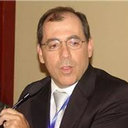Neuraminidase-1 mediates skeletal muscle regeneration.
Palabras clave
Abstracto
Neuraminidase-1 (NEU1) is the sialidase responsible for the catabolism of sialoglycoconjugates in lysosomes. Congenital NEU1 deficiency causes sialidosis, a severe lysosomal storage disease associated with a broad spectrum of clinical manifestations, which also include skeletal deformities, skeletal muscle hypotonia and weakness. Neu1(-/-) mice, a model of sialidosis, develop an atypical form of muscle degeneration caused by progressive expansion of the connective tissue that infiltrates the muscle bed, leading to fiber degeneration and atrophy. Here we investigated the role of Neu1 in the myogenic process that ensues during muscle regeneration after cardiotoxin-induced injury of limb muscles. A comparative analysis of cardiotoxin-treated muscles from Neu1(-/-) mice and Neu1(+/+) mice showed increased inflammatory and proliferative responses in the absence of Neu1 during the early stages of muscle regeneration. This was accompanied by significant and sequential upregulation of Pax7, MyoD, and myogenin mRNAs. The levels of both MyoD and myogenin proteins decreased during the late stages of regeneration, which most likely reflected an increased rate of degradation of the myogenic factors in the Neu1(-/-) muscle. We also observed a delay in muscle cell differentiation, which was characterized by prolonged expression of embryonic myosin heavy chain, as well as reduced myofiber cross-sectional area. At the end of the regenerative process, collagen type III deposition was increased compared to wild-type muscles and internal controls, indicating the initiation of fibrosis. Overall, these results point to a role of Neu1 throughout muscle regeneration.


